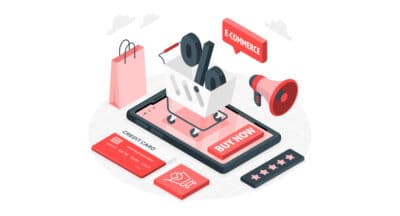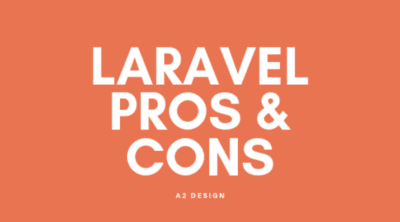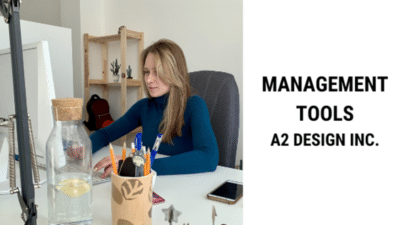SDaaS: What is Software Development as a Service? Comprehensive Guide

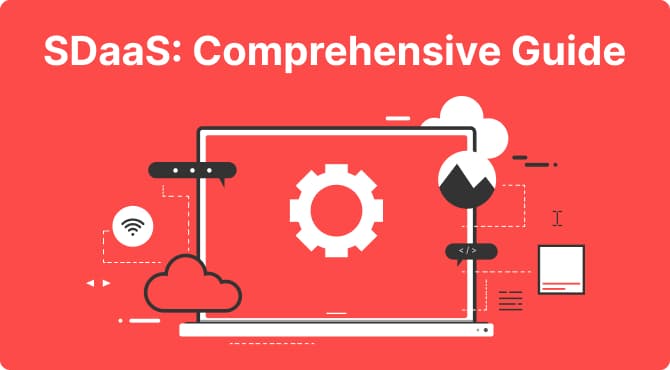
Have a killer idea to build an app or software but don’t know how to turn your vision into reality? Or you simply don’t want to deal with the terrifying software development quagmire? Fear not, intrepid entrepreneur, this is where partnering with a Software Development as a Service (SDaaS) company can help you.
SDaaS is a transformative approach designed to revolutionize the way businesses plan and execute their app development projects. By collaborating with an SDaaS company, you can launch a game-changing app faster, more efficiently, and with less stress.
In this guide, we’ll discuss everything you need to know about Software Development as a Service. Whether you are a startup planning to launch the next million-dollar app or an enterprise looking to revamp your website, the insights shared in this guide can meet your needs.
Read Related
By the end of this guide, you’ll have learned about:
- Understanding SDaaS: Unpacking the definition and key components.
- Benefits of SDaaS: Exploring the game-changing advantages.
- SDaaS Workflow: A step-by-step guide through the development process.
- SDaaS Tools and Platforms: Navigating popular providers and tools.
- Challenges and Considerations: Addressing potential roadblocks.
- Case Studies: Real-world examples of SDaaS success stories.
Get ready to unveil the secret of SDaaS and how it can benefit your business.
Demystifying SDaaS: Features, Benefits, and How It Works
SDaaS, in a nutshell, is like outsourcing a software development company on steroids. It is a comprehensive, cloud-based ecosystem designed to streamline the entire app development lifecycle, from initial conceptualization to development to deployment and ongoing maintenance.
By partnering with an SDaaS company, you don’t just hire app developers, but you gain access to a whole freelancer of programmers, designers, and project managers, all collaborating to make your dream app a reality.
Deep Dive into SDaaS: How it Works
While every business is unique, and so is every business-SDaaS collaboration, here is how a typical SDaaS partnership works:
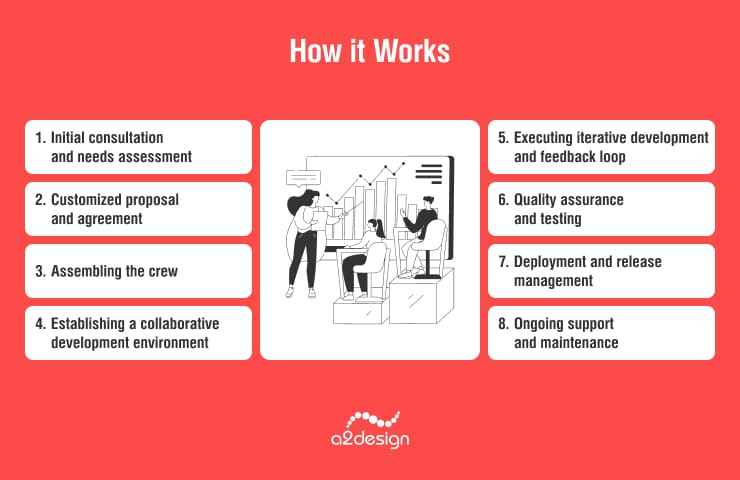
- Initial Consultation and Needs Assessment: Your business and the SDaaS company meet for an initial consultation. Here, the SDaaS provider gets acquainted with the client’s business, goals, and challenges. Through in-depth discussion, the SDaaS provider identifies your specific requirements, desired outcomes, and project scope.
- Customized Proposal and Agreement: Based on the initial assessment, the SDaaS provider crafts a customized proposal outlining the solution for your business, engagement model, and pricing structure.
- Assembling the Crew: Your SDaaS provider handpicks the personnel that will form your team according to your objectives and needs. Depending on the engagement model, the SDaaS provider may integrate with your own team to foster collaboration and synergy.
- Establishing a Collaborative Development Environment: After the team has been assembled, the SDaaS provider establishes a collaborative development environment—typically cloud-based—-to ensure accessibility, real-time collaboration, and scalability.
- Executing Iterative Development and Feedback Loop: Many SDaaS providers leverage agile methodologies to enable iterative development cycles that align with evolving project requirements. During the execution phase, the provider also maintains regular feedback sessions to gather valuable insights to steer the project in the desired direction.
- Quality Assurance and Testing: The SDaaS provider integrates quality assurance and rigorous testing into the project execution, ensuring that the app/software meets the desired quality standards.
- Deployment and Release Management: By leveraging efficient release management strategies as well as automated tools, the SDaaS provider can help you plan and execute a streamlined transition from development to deployment to minimize downtime and ensure a seamless user experience.
- Ongoing Support and Maintenance: The partnership between your business and the SDaaS continues beyond the development and deployment phase. You can expect ongoing support and proactive maintenance from the SDaaS provider via regular reviews and feedback sessions to ensure continuous improvement of your app, addressing evolving user needs.
As you can see, collaborating with an SDaaS allows you to have a dynamic partnership where you can gain access to expertise and resources to help you not only achieve your goals but also drive innovation.
SDaaS vs. Traditional Outsourcing
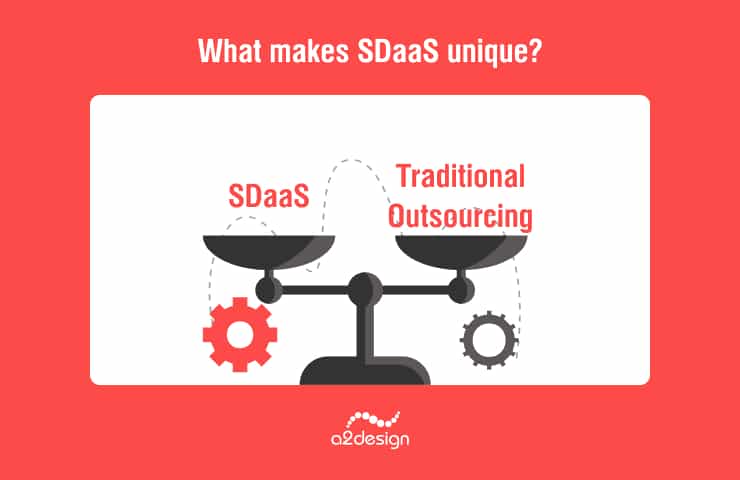
Here’s what makes SDaaS unique over traditional outsourcing:
- Flexibility: Whether you need a small team of developers for a quick Proof of Concept (POC) (link to POC/prototype article here), or a full squad for a complex app development project, an SDaaS can easily scale up and down according to your current needs. In traditional outsourcing, scalability is often minimal or non-existent.
- Expertise: Trustworthy SDaaS providers like A2 Design gather the best of the best developers, designers, and security experts to ensure your project has the expertise to conquer any challenge.
- Collaboration: SDaaS providers leverage real-time collaboration tools to ensure constant, consistent, and transparent communication. This can significantly help reduce development bottlenecks, accelerating project timelines.
Different Types of SDaaS Models
Different app development has different needs, and this is why there are several different types of SDaaS based on engagement models:
- Project-Based: In this model, the SDaaS provider will only partner with you in tackling one short-term project with a defined scope and clear deadlines. The partnership will last for the duration of the project lifecycle and can be renewed when needed. This engagement model is ideal for businesses with specific and well-defined app development projects.
- Retainer-Based: In this model, the business retains the SDaaS services for a timeframe agreed on in the retainer contract. This model provides ongoing on-demand access to a dedicated SDaaS team so you can ensure consistency and availability.
- Dedicated Team: In this model, the SDaaS provider basically builds you a custom team that is dedicated exclusively to your project, essentially becoming a part of your company’s operations. This model is typically the most expensive, but at the same time offers a higher level of personalization and collaboration.

When not managed well, developing and launching an app can feel like fighting a resource-hungry uphill battle. Between talent recruitment issues, skyrocketing costs, and endless debugging, it’s probably enough to make you want to give up.
Yet, an SDaaS model can significantly help your business with a variety of transformative advantages:
1. Cost-Effectiveness:
Partnering with an SDaaS reduces or even eliminates the need for substantial upfront investment both in terms of talent and infrastructure. This makes SDaaS a more cost-effective solution for most app development needs.
You can:
- Forget the Need of Building an In-House Team: Office space, salaries, and benefits are expensive, and SDaaS allows you to access experienced top-tier talent without the overhead.
- No More Freelancer Follies: While working with freelancers do have its perk, unreliability, inconsistent quality, and the hassle of bidding wars can be a major hurdle. SDaaS offers a stable and predictable budget with consistency in expertise.
2. Improved Flexibility and Scalability
With SDaaS it’s very easy to resize your dev team on the fly, which used to be a time-consuming process in the traditional approach. You can dynamically adjust your team and resources size according to your changing needs.
This improved flexibility lets you easily adapt and pivot to market shifts or evolving business goals while maintaining agility.
3. Faster Time-to-Market
SDaaS ensures a streamlined workflow, accelerating development cycles and reducing time-to-market for your app or software. This is made possible with the SDaaS provider’s collaborative environment and automated processes, so you can launch your app before the competition even smells your existence, ensuring a competitive edge.
4. Access to Expertise and Talent
In a traditional outsourcing approach, building an in-house team may limit access to a specific skillset.
An SDaaS provider can provide you with access to a pool of talents with diverse skillsets so you can tap into the right talent according to your needs without the associated recruitment hurdles.
Not to mention, SDaaS providers stay ahead of the curve and constantly recruit talented experts while staying up-to-date with the latest tech trends. This allows you to access cutting-edge talents and technologies without needing to train your own team, keeping your tech stack and talent competitive.
5. Improved Quality and Innovation
In a traditional outsourcing approach, maintaining quality of work (especially code quality) can be challenging due to the lack of standardized processes. SDaaS, on the other hand, enforces best practices, automated testing, and version control, resulting in consistent, high-quality code that adheres to industry standards.
DaaS providers also invest in staying current with emerging and cutting-edge technologies so your business can gain access to these latest technologies and tools without additional burdens.
6. Reduced Risk and Shared Responsibility
Your SDaaS partner shares accountability, mitigating your business’s risks while offering a safety net in the event of unforeseen challenges. Shared responsibilities offered by the SDaaS providers will provide you with a comprehensive approach that spans the entire app development lifecycle.
Finding The Ideal SDaaS Partner: A Strategic GuideConvinced that collaborating with an SDaaS partner is the right approach for your app development needs? Congratulations! You are already on the right track.
However, selecting the right Software Development as a Service Partner can be a challenge on its own, and yet it is a critical decision that can literally make or break your app development endeavor’s success.
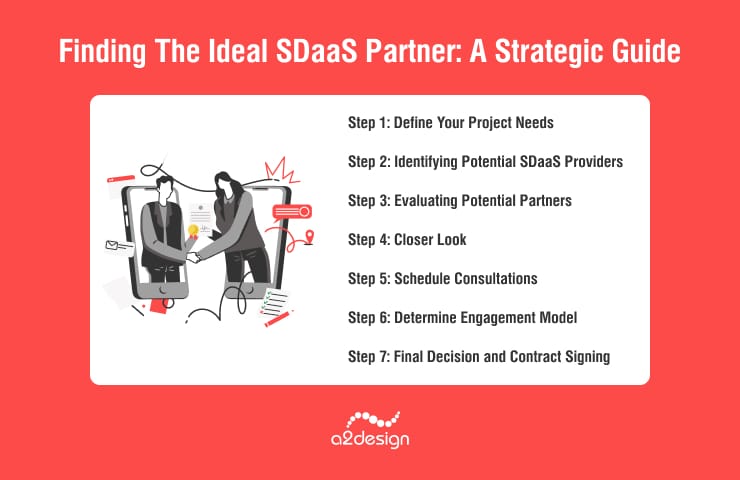
With so many SDaaS providers out there, how should you navigate this partnership maze? Here is your roadmap:
Step 1: Define Your Project Needs
Before beginning your search, it’s recommended to first clearly identify your needs.
Start by outlining the scope of your app development project by:
- Defining Your Vision: What problem are you trying to solve with your app? What features and functionalities will be needed to bring your vision to life? Be as detailed as possible.
- Breaking It Down: Try to break your project into manageable milestones or phases. Which core features would you prioritize first? These milestones will help you keep your progress measurable and tangible.
- Define Your Deliverables: Clearly outline what you expect at each milestone or phase. Specify tangible outputs like Proof of Concept (POC), wireframes, prototypes, etc. It’s best not to leave any room for ambiguity.
- Timeline: Set realistic timelines for each phase while considering dependencies between each phase. When negotiating with potential providers, knowing your timeline can help you evaluate whether they can work according to your pace.
- Define Technical Requirements: Do you have any specific technologies in mind? Will your app be mobile-centric, cloud-based, or other? Does your software need to integrate with other platforms or systems? Clearly define the desired performance benchmarks like speed, security, and scalability.
- Budgeting: Determine a realistic budget constraint. Knowing your financial limitations can significantly help in narrowing down your SDaaS provider options.
Step 2: Identifying Potential SDaaS Providers
Build a shortlist of potential SDaaS partners. Consider the following in your search for potential partners:
- Industry Directories: Try exploring directories like UpWork, GoodFirms, Clutch, or others that may showcase SDaaS providers.
- Industry Events and Conferences: Networking at conferences and industry events may allow you to speak directly with potential SDaaS providers so you can get a feel for their expertise, experience, and culture.
- Referrals: Ask colleagues, vendors, business partners, and fellow entrepreneurs for recommendations. Especially look for others who have used SDaaS services in the past so you can get objective insights.
Step 3: Evaluating Potential Partners
Once you’ve identified potential SDaaS partners, After you have found some potential SDaaS partners, you can begin to examine your options in more detail.
There are a few areas you can explore:
- Proven Track Record: Examine the SDaaS provider’s track record by:
- Case Studies: Evaluate whether they have enough experience in your industry or with similar projects. If possible, seek references from previous clients.
- Portfolio: You’d want to look for providers that have enough experience in similar projects. A diverse portfolio also showcases the provider’s experience and capabilities across different technologies and domains.
- Domain Expertise: Dig into the provider’s team composition and evaluate:
- Industry Alignment: You’d want an SDaaS provider with enough expertise in your industry. Evaluate whether they have a deep understanding of your specific requirements and challenges.
- Technical Proficiency: Assess whether they have developers with the specific skills required in your project. Also, evaluate the technical proficiency in relevant technologies.
- Communication Style: Evaluate the provider’s communication style:
- Clear Communication Channels: Assess the provider’s communication channels. Do they offer regular updates? Do they maintain responsive interactions and a collaborative approach?
- Cultural Fit: Evaluate cultural nuances to ensure effective collaboration and communication between your team and the provider’s team.
- Security Practices: When partnering with an SDaaS provider, you’ll give them access to your business’s (sensitive) information, so it’s critical to evaluate:
- Data Security Measures: Inquire about the SDaaS provider’s security measures, including data encryption, access controls, and compliance with industry standards.
- Incident Response Plans: Evaluate whether the provider is prepared with incident response plans in case of data breaches or cybersecurity attacks.
Ready to Create an App?
Contact UsStep 4: Closer Look
With the evaluation you’ve conducted, you’ve probably been able to narrow down the candidates by now. It’s time for a closer examination:
- Compare and Contrast: Compare the offerings of the providers in your shortlist side-by-side. Consider factors like project alignments, expertise, communication style/culture, and, obviously, cost. A closer comparison can help you choose the best possible provider that suits your needs.
- Scrutinize the Fine Print: Some SDaaS providers are guilty of handing unrealistic promises and guarantees. It’s critical to dig into the provider’s pricing structure, contracts, and service level agreement to make sure there aren’t any hidden clauses.
Step 5: Schedule Consultations
Once you’ve further narrowed down your options, schedule in-depth consultations with the last few candidates. This allows you to further assess the provider’s understanding of your vision, collaboration/communication fit, and potential roadblocks. You should:
- Interact With SDaaS Team: Make sure you can interact with the development team so you can directly gauge their expertise, understanding of your project, and communication skills.
- Establish Communication Channels:
- Regular Updates: Make sure they are committed to providing regular updates on project progress, milestones, and any identified issues.
- Project Management Tools: Assess whether the provider uses collaborative project management tools to facilitate real-time tracking and transparency.
- Mutual Understanding of Project Goals: It’s critical to establish a mutual understanding of your project’s goals so you can ensure alignment with business objectives.
- Agreeing on Success Metrics:
- Establish KPIs: Define KPIs and success metrics so you can keep track of project performance.
- Timelines and Milestones: Clearly define critical milestones/phases and timelines for each.
- Quality Benchmarks: Establish benchmarks for code quality, standards for testing, and overall project quality.
Step 6: Determine Engagement Model
After all these steps, by now, you should be able to narrow down or even finalize your choice. The next step is to determine an engagement model for your partnership:
- Project-Based Engagement: Opt for a project-based engagement for well-defined projects with specific timelines and deliverables.
- Retainer-Based Model: Choose a retainer-based model for ongoing support and maintenance, providing a dedicated resource pool.
- Dedicated Team: Consider a dedicated team model for exclusive access to a team of developers, fostering deep collaboration and flexibility.
Step 7: Final Decision and Contract Signing
- Request Final Proposal/Quotes: Request the customized and finalized proposal from the provider of your choice.
- Clarify Terms: Make sure you’ve read and 100% understood all terms and conditions in the contract, including project timelines, payment schedules, and any hidden costs.
- Contractual Agreements: Review and finalize contractual agreements before signing, and make sure you clearly understand and agree on project deliverables, responsibilities, and timelines.
In this demanding and dynamic world of app/software development, SDaaS (Software Development as a Service) emerges as a viable solution for businesses looking for more innovation and efficiency in developing their apps.
Let’s recap the key takeaways we’ve learned in this guide:
- Cost Efficiency and Accessibility:
- SDaaS minimizes upfront investments, reducing operational costs.
- Cloud-based environments provide accessibility and flexibility, enabling teams to collaborate seamlessly.
- Flexibility and Scalability:
- Businesses can dynamically adjust resources, adapting to changing project needs effortlessly.
- Agile response to market changes ensures resilience in a dynamic business environment.
- Access to Expertise and Accelerated Timelines:
- SDaaS unlocks access to a diverse pool of skilled developers with specialized expertise.
- Accelerated development cycles translate to faster time-to-market for software products.
- Quality and Innovation:
- Enforced best practices and continuous collaboration ensure high-quality code.
- Access to the latest technologies fosters innovation and future-proof solutions.
- Risk Mitigation and Shared Responsibility:
- SDaaS providers share accountability, mitigating risks for businesses.
- A collaborative approach ensures shared responsibility throughout the software development lifecycle.
Out of all the SDaaS providers available in the market today, A2 Design stands ready to be more than just your SDaaS partner, but your collaborator in your journey for information.
With A2 Design as your SDaaS partner, you can expect:
- Unleash Your Software Potential: A2 Design frees you from resource constraints and empowers rapid development.
- Tailored Solutions: A2 Design crafts unique SDaaS experiences that align with your specific needs and goals.
- Evolving Landscape: We embrace the dynamic nature of SDaaS and keep you ahead of the curve.
- Free Consultation: Take the first step towards your digital transformation with a no-obligation consultation.
Contact us today, and let the magic begin!


